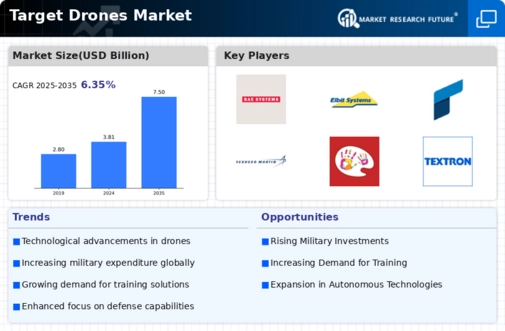Top Industry Leaders in the Target Drones Market

The Target Drones Market has emerged as a critical segment within the defense industry, providing realistic training scenarios for armed forces and serving as test platforms for the development and evaluation of various weapon systems. This comprehensive overview delves into the competitive landscape, encompassing key players, strategies, market share analysis factors, emerging companies, industry news, and investment trends.
Strategies Adopted By Key Players Target Drones Market
- ASV GLOBAL (UK)
- AEROTARGETS INTERNATIONAL, LLC (US)
- THE BOEING COMPANY (US)
- QINETIQ GROUP PLC (UK)
- NORTHROP GRUMMAN CORPORATION (US)
- SAAB AB (SWEDEN)
- AIRBUS S.A.S GROUP (FRANCE)
- LEONARDO S.P.A. (ITALY)
- LOCKHEED MARTIN CORPORATION (US)
- BSK DEFENSE S.A. (GREECE)
- AIR AFFAIRS AUSTRALIA PTY LTD (AUSTRALIA)
- L3 ASV (UK)
- BAE SYSTEMS (UK)
- RAYTHEON (US)
- GENERAL DYNAMICS CORPORATION (US)
- ALMAZ-ANTEY (RUSSIA)
- THALES (FRANCE)
- EMBENTION (SPAIN)
- GRIFFON AEROSPACE (US)
- DENEL DYNAMICS (US)
Key players in the Target Drones Market employ strategic initiatives to maintain and strengthen their market position. Continuous investment in research and development is a common strategy to introduce innovative target drone technologies, including enhanced autonomy, realistic flight profiles, and electronic warfare capabilities for realistic training scenarios. Moreover, strategic collaborations with defense agencies, international partnerships, and technology providers facilitate the development of tailored solutions, ensuring that target drones meet the evolving needs of armed forces across different domains.
Factors for Market Share Analysis:
Market share analysis in the Target Drones Market is influenced by several critical factors. The realism and fidelity of target drone simulations, adherence to military specifications and requirements, and the ability to provide cost-effective and scalable solutions are pivotal. Companies that excel in delivering target drones with high maneuverability, realistic threat representations, and adaptability to various mission scenarios are likely to secure a significant share of the market. The capacity to address the diverse training needs of different military branches and weapon systems, including air-to-air and surface-to-air engagements, is also crucial in determining market dominance.
New and Emerging Companies:
In the evolving landscape of the Target Drones Market, new and emerging companies are making noteworthy strides. Start-ups like Aerodyne Industries and Composite Engineering, Inc. bring innovative approaches to target drone technologies, focusing on affordability, modularity, and adaptability to emerging threats. These companies contribute agility and niche expertise to the market, challenging traditional approaches and introducing disruptive technologies that address specific challenges in modern military training and testing.
Industry News:
Recent industry news underscores the dynamic nature of the Target Drones Market, with reports of successful target drone demonstrations, partnerships between target drone manufacturers and defense contractors, and advancements in technologies such as swarming capabilities and electronic warfare countermeasures. Additionally, news regarding the integration of artificial intelligence into target drone systems, the development of maritime target drones for naval exercises, and international collaborations for joint training exercises highlight the industry's commitment to staying at the forefront of evolving defense requirements. Such developments contribute to the evolving landscape and indicate a shift towards more advanced and realistic target drone solutions.
Current Company Investment Trends:
Investments in the Target Drones Market reflect a commitment to advancing technology and addressing the evolving needs of modern military training and testing. Key players are investing significantly in research and development to enhance the capabilities of target drones, improve simulation fidelity, and address emerging challenges such as anti-access and area denial scenarios. Strategic acquisitions and partnerships to expand solution portfolios, ensure interoperability, and address evolving threats are common investment trends. Furthermore, advancements in swarming technologies, artificial intelligence integration, and data analytics for post-mission analysis are notable focus areas, aiming to enhance the overall effectiveness of target drone simulations.
Overall Competitive Scenario:
The overall competitive scenario in the Target Drones Market is characterized by a blend of established players providing comprehensive solutions and innovative newcomers introducing disruptive technologies. As armed forces worldwide seek realistic and cost-effective training scenarios, the competition revolves around delivering target drones that offer high fidelity, adaptability to different mission profiles, and scalability for various training environments. The ongoing evolution of military tactics and the need for realistic testing of weapon systems further shape the competitive dynamics in the market.
Recent Development:
January 2024:
Kratos Defense & Security Solutions (USA): Won a USD 195 million contract from the US Air Force for its BQM-177A subsonic aerial targets (SSATs). This reinforces their position as a leading provider of high-performance target drones.
Leonardo S.p.A. (Italy): Unveiled the M-346 FA fighter trainer aircraft, boasting enhanced multi-role capabilities including acting as a target drone for advanced weapon system testing.


